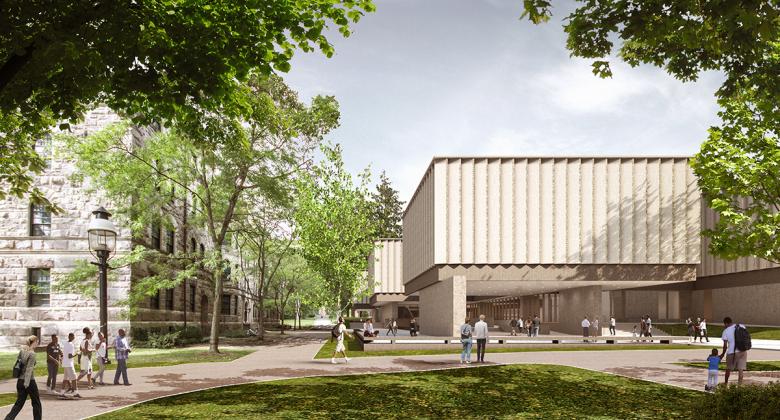A Peek Inside Princeton University Art Museum
Renderings of Adjaye Associates' design of the Princeton University Art Museum's new building have been revealed. Slated to open in 2024, the new building aims to embody "flexibility, openness and connectivity to break down barriers to participation and invite entry by all."
Sir David Adjaye presented his firm's design for the new building yesterday with James Steward, director of the Princeton University Art Museum, during a virtual press conference. There are many goals to the project, but the main reason for the new building is to expand its footprint, both for the display of art and for social gatherings. The popular museum will double the square footage of its existing facility while providing flexible spaces for various events; the current building lacks event spaces, such that gatherings have taken place on the green spaces adjacent to the museum.
The museum is centrally located on the university's campus in Princeton, New Jersey, at the nexus of a couple of the campus's lovely tree-lined walks. The museum is already pierced by a north-south path aligned with the nearby Whig Hall (renovated by Charles Gwathmey in 1975). Adjaye's plan not only maintains this path through the new museum building, he amplifies its role, creating an "art walk" beneath the new buildings and direct access to its main entrance from the walkway. A perpendicular path from the east, near the School of Architecture, will provide a secondary entrance to the new building.
The existing museum, located in McCormick Hall, will be entirely demolished, minus Marquand Art Library. Adjaye's three-story design will then basically wrap the library on three sides, creating a museum with "all fronts and no backs." The plan arranges the galleries as seven square pavilions — four at the corners and three in-between, with one facing west, one facing south, and one facing east. Clad in serrated stone that alternates rough and polished surfaces, the pavilions are sized relative to the surrounding older buildings on campus in an effort to give a smaller scale to the sizable museum.
To deal with the slope of the site and increase the accessibility of the museum, the majority of the galleries will be located on the second floor, one level up from the art walk the passes beneath the pavilions on the west side of the museum. This plan will also enable the curators to the flatten the distinctions between chronological and geographical differences in their display of artworks. Other institutions, such as LACMA with its one-story building designed by Peter Zumthor, are taking similar approaches these days, in an effort to break down hierarchies that have long preferred certain types of art over others.
The main entrance, accessed from the art walk, will deliver visitors in roughly the center of the museum, where the Grand Hall will provide peeks into the gallery spaces and entice people upstairs. This hall will also double as an event space and offer flexible configurations for parties, lectures, concerts, and the like. Adjaye was influenced by such precedents as Louis I. Kahn's Yale Center for British Art and in turn designed top-lit galleries and other spaces beneath wood-clad structural grids.
In addition to the sizable galleries occupying the pavilions, Adjaye has designed more intimate spaces that will give the curators more variety in how they display art. (There will also be terraces for the display of sculptures outside.) One such space is visible at top, a small room in the northeast corner with views toward the east-west McCosh Walk. Appended to the serrated facade, this small box with windows should be intriguing for those walking past the museum. This corner and other windows breaking up the predominantly solid exterior illustrate Adjaye's desire to unite interesting views of the building with carefully framed views from inside the building and to "invite entry by all."
Adjaye Associates was selected to design the new home for the Princeton University Art Museum in September 2018, in collaboration with Cooper Robertson as executive architect. Construction is slated to begin in 2021 with an anticipated opening in late 2024.






